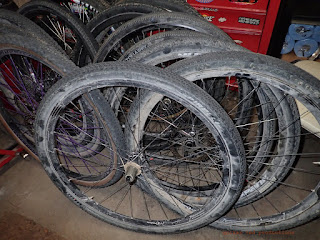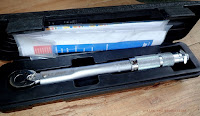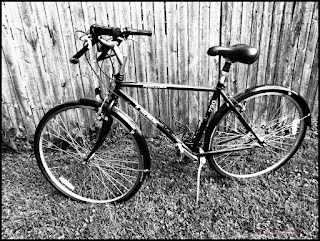 |
Torque specs and proper application of torque is critical for cyclists.
|
Today's post is courtesy of G-Ted Productions reader, "Sean", who suggested that a post covering torque wrenches and what I thought of them was probably a good idea. He's right, and so today I am going to cover the basics of torque wrenches. What torque wrenches I like will be detailed. I will also cover reasons why using proper torque on fasteners is important. So off we go now.....
What It Is: Torque is important and you use it everyday. Anytime you screw on or unscrew a lid, cap, or fastener, you are applying torque. When it comes to your bicycle, this ends up being very important because without torque your bicycle would fall apart, and well.....you wouldn't be pedaling either. "Proper" torque is when you have applied a specified force to a fastener so that it (hopefully) will not break or come undone during use, and so that the parts joined together won't fail because of improper torque. Basically, too tight or too loose is bad. We want to be in that "Goldilocks" area, but how do you know when you have your fastener 'in the zone'? Well, you don't know nuthin' without measuring tools. That's where torque wrenches come in.
A good torque wrench will give you a measurement that you can check against the specifications for the part you are fastening. For instance, many stem bolts have a 4-5N m. torque specification. Going less than 4N m. is not good and going over 5N m. is not good. The torque wrench will tell tell you when you have that fastener in that 4-5 Newton meter range. (Yes, that is what "N m." stands for) I'm not going to get all into the units of measure for torque here, but the most commonly used units for bicycles are Newton meters, and to a much lesser degree, pound-feet , and inch-pounds.
 |
An example of beam/deflection torque wrenches
|
Types Of Torque Wrenches:There are four types of torque wrenches in use in bicycle shops: Beam/Deflection, Clicker, Digital, and Dial Gauge. Most accept 1/4" or 3/8th" socket tools and some have the hex type bit pockets.
Beam/Deflection: These are probably less commonplace in bicycle shops these days, but beam/deflection style torque wrenches are simple and low maintenance. They do have a disadvantage though in that it takes a steady, skilled hand to use one properly. It's easy, for instance, to miss your target torque range when getting into higher torque settings since you have to rely on muscle steadiness to get an accurate reading. The plus side is that these types of wrenches, if handled with care, do not go out of spec. This means that when a beam type wrench measures 5 pound-feet of torque today, it will still be 5 pound-feet of torque 20 years from now when it gets used again. (I know because I have two and have had them tested) Beam/Deflection wrenches are usually big and ungainly compared to other options though.
Dial Type: These are similar to Beam/Deflection wrenches but they use a dial embedded into the wrench to read out torque applied. These wrenches are the ones which were prevalent for many years in auto mechanic shops 30 years ago and more. They will need calibration from time to time to remain accurate. Generally speaking, these are also a bit large and ungainly, and are not generally found in bicycle shops. Besides needing calibration from time to time, dial type torque wrenches need extra special care so as to keep those glass lens covers on the dial gauge intact.
Digital: Now we are getting into wrenches which are typically found in many bicycle shops today and which are made for home mechanic use. I have this Topeak digital wrench which I used in a shop setting for a while until it died. Typical digital wrenches are set up for 1/4" sockets or hex shaped bits. These wrenches work by means of strain gauges, typically.
The digital wrench will typically use a sound when proper torque has been reached, and it will give you a digital read-out as well. Usually these read-outs will stay on screen until you dismiss them. That's handy if you want to stop for any reason and wonder afterward where you were.
Some do all of the above and 'click' over when the proper torque has been reached. These are nice because you get an audible and tactile alert when the torque specification has been reached. But either way, any of these wrenches will need periodic re-calibration to remain accurate.
Click Type: These are the other type of torque wrench which you will find often times in a bicycle shop. The Click style wrench will 'click' and the lever arm will 'jump' a tiny bit in the hand when proper torque has been reached. These typically are seen in either 1/4' or 3/8ths" socket tool style and good ones can be just as accurate as a digital wrench.
Click style wrenches also need to be re-calibrated every so often and, as with all torque wrenches, they need to be handled with extreme care. Many bike tool companies do click style wrenches and support them when it comes to re-calibration.
Another sub-set of 'click' style torque wrenches exists and these are smaller with sometimes a dedicated bit, or limited bit sizes for the most common fasteners on a bicycle. These are very popular with home mechanics and hobbyist repair people due to their inexpensive cost and smaller, portable size.These types of torque tools typically are not certified for their torque range and cannot be calibrated.
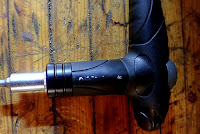 |
An example of a smaller, 'click' style torque tool.
|
Which Torque Wrench Is Right For You?
The proper torque wrench for anyone working on bicycles will be determined by a few factors. First, it must read out in Newton-meters. This is by far the most commonly used measurement for torque on a bicycle. Secondly, you need to know what parts you want to torque and what specification range you will be working in. It does no good, for instance, to have a wrench which measures from 20N m. to 200 N m. if all your fasteners require between 3N m. and 15N m. So, match the range of the tool to your needs. This requires research on your part. But I can tell you that automotive torque wrenches are definite overkill. Unless you already own digital or click style wrenches for automotive, then skip that segment and buy wrenches meant for the bicycle trade.
The third factor here is to figure out how often you will be disassembling/assembling parts on your bicycle. Is this a wrench for 'just in case', or is this a wrench for your tool kit because you swap out parts monthly? If you don't see yourself messing with parts swapping, a simple "torque key" style tool will get you where you can periodically check things like stem bolt tightness, for instance. Constant parts swapping and tear-down/build-up of bikes will require a more serious tool.
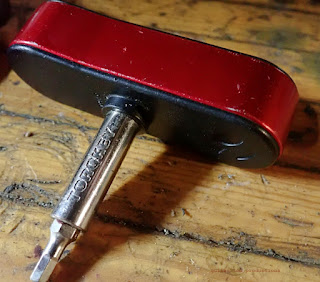 |
This fixed bit 'torque key' tool might be all you need.
|
Another determining factor may be that you may feel comfortable changing out stems and seat posts, but anything beyond that goes to the bike mechanic. Then all you might need is a simple digital torque wrench like that Topeak one above.
Bigger jobs will require bigger wrenches and more durable wrenches like that silver Unior wrench above. In fact, you may find that- like me- you need several types and styles of torque wrenches to cover any scenario.
Care And Feeding Of Torque Wrenches:
If you've been reading so far, you've noted that I've brought up that torque wrenches need to be handled with "extreme care". This is no joke. Simply dropping a torque wrench can throw it so far out of spec that it would be dangerous to rely upon it afterward. A digital torque wrench may even be damaged beyond repair if dropped, or if you drop a heavy tool on it in a drawer, for instance. This is why you see many torque wrenches in protective cases. Keep those and ALWAYS store your torque wrench in it. NEVER drop a torque wrench and use it afterward without checking its accuracy. (Typically this means sending it in to be re-calibrated and certified) See the papers which I have in the Unior case in my image above? Those are certification papers on my wrench. Yes- these are precision measuring tools and should be handled with extreme care. No joke.
Conversely, a torque key style tool should only be used in instances where you are checking torque of an already fastened part. These should never be used in assembly situations. Also, it should be noted that you shall NEVER USE A TORQUE WRENCH TO UNSCREW A FASTENER. Well,unless you don't care about accuracy. This even goes for torque key tools. Just don't do it. That's what regular tools are for.
 |
Detail shot of my Unior torque wrench.
|
What's My Favorite?I bought a torque wrench a few years ago and before I did I determined that this wrench was going to be used on a consistent basis in a shop setting. I needed it to measure Newton meters primarily and within a range of 4N m to 20N m maximum. I did not want a digital wrench after having that Topeak one above which failed on me after about a year of use. (To be fair, the Topeak one is not really a 'daily shop use' type of tool)
My research led me to Unior, and I've been very happy with this particular one I have. However; I now work at Andy's Bike Shop where he has a similar wrench from PRO, (Shimano's accessory/tool brand) and it also works very well. I would highly recommend either for 'serious' home usage.
The Topeak wrench could also be a good home mechanic wrench if you are not constantly using it. When mine worked it was great, and I would not hesitate to recommend it for the serious home mechanic.
Torque key type wrenches are okay for checking tightness of components, but I do not recommend them as 'assembly tools' for any reason. They generally are not calibrated or certified to a high standard, and with today's parts being so sensitive to torque, I would not rely on these tools to be accurate after being used several times for assembling bits. Checking on torque? Yes. Place one gently in your kit to double-check torque before a big ride. But don't buy one of these thinking you can 'get by' and assemble a bicycle safely with any modicum of accuracy.
Oh, and those beam/deflection wrenches? I have those as back-up in case I have to send in my Unior for any reason. I wouldn't recommend them to most bicycle mechanics, but in a pinch, these are better than not using a torque wrench if used with care.
There is a LOT more to torque wrenches that I am not touching upon here. Things like how to use them and what to do with fasteners and more. Those are things you should research. But I hope that this primer on the subject of the torque wrench itself is useful.
Thanks to "Sean" for the prompt to write this. Thank you for reading G-Ted Productions.





